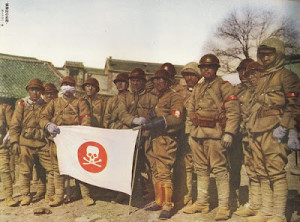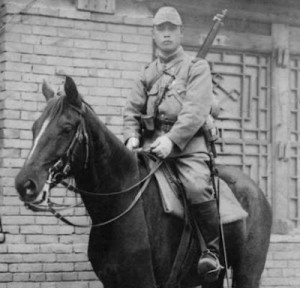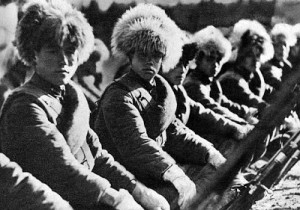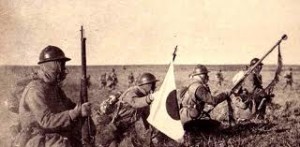Frontier Mavericks: Japan’s Kwantung Army
- By Peter Harmsen
- 7 September, 2013
- 24 Comments
 Japan’s Kwantung Army, a unit operating in what is now northeast China, exemplified the emperor’s soldiers at their most death-defying, if not death-worshipping, as the photo on the left suggests. But the Kwantung Army was also a key actor in the complex strategic game over East Asia in the 1930s. Read on in this article first carried on the Warfare History Blog:
Japan’s Kwantung Army, a unit operating in what is now northeast China, exemplified the emperor’s soldiers at their most death-defying, if not death-worshipping, as the photo on the left suggests. But the Kwantung Army was also a key actor in the complex strategic game over East Asia in the 1930s. Read on in this article first carried on the Warfare History Blog:
The culture of the Japanese Army and its rigid command structure is critical in analyzing the strategies used by them in China from 1931-1939. The Kwantung Army was an anomaly in the greater study of the Imperial Japanese Army (IJA) from 1900-1945, in that it often took extra-judicial measures in its occupied territories and theatres of operations. Formed in 1919 from the original Kwantung Garrison, which since 1906 had guarded the southern Manchurian railway from bandits or enemy nations, the Kwantung garrisoned the Liaodong Peninsula. Occupation of this territory had begun during the First Sino-Japanese War of 1894-1895.
Soon dominated by young officers who privatized and isolated command, the Kwantung often operated under regional command structures. This so called “loyal insubordination” became the key to the Kwantung’s military doctrine whilst serving in Manchuria and Northern China beginning in the early 1920’s. Economically the region which the Kwantung occupied as border police and railway guards was a boom area where farming, steelworks, and other raw material awaited the growing Japanese Empire. Their military units were often aggressive and entirely disdainful of both Japanese and Chinese civilian authority.

Kwantung cavalry, Manchuria 1937
In one incident a major group officers assassinated a pesky Manchurian warlord in 1928 by arranging for a bomb to be placed on his personal railcar. Evidence suggests that the Kwantung’s unofficial policies may have indirectly led to their involvement in many major confrontations with Soviet border armies beginning in the mid 1920’s. Their belligerence was most evident in Northern China. In 1931 the Kwantung army engineered the Mukden Incident eventually spearheading in the invasion of Manchuria in September of the same year. Though some resistance was encountered in Manchuria it was eventually pacified and a puppet government installed. The Manchukuo state which lasted from 1932-1945 was effectively administered, defended, and ruled by the Kwantung. Emperor Puyi (b.1906-1967), twice the Emperor of Qing China before his overthrow during the Revolution of 1911-1912, was the nominal head of state.
The Kwantung’s belligerence in 1937 and 1938 led in part to the Battle of Khalkhin Gol in 1939 and its escalation into a major theater of war from May to September. It should be noted that while the campaign in the Khalkhin Gol was long and many troops were committed to Mongolia the bigger conflict taking place on the Chinese mainland was still the primary concern for Tokyo during this period. General Tojo had served in China and Inner Mongolia with the IJA and would later hold command of the intelligence and military police until 1938 when he was recalled to Japan to begin his political career. [1]

Kwantung Army infantry, equipped for the harsh winter


 Copyright © 2025
Copyright © 2025
Leave a Reply